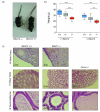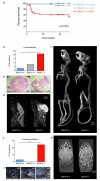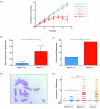Disruption of mouse Slx4, a regulator of structure-specific nucleases, phenocopies Fanconi anemia
- PMID: 21240276
- PMCID: PMC3624090
- DOI: 10.1038/ng.752
Disruption of mouse Slx4, a regulator of structure-specific nucleases, phenocopies Fanconi anemia
Abstract
The evolutionarily conserved SLX4 protein, a key regulator of nucleases, is critical for DNA damage response. SLX4 nuclease complexes mediate repair during replication and can also resolve Holliday junctions formed during homologous recombination. Here we describe the phenotype of the Btbd12 knockout mouse, the mouse ortholog of SLX4, which recapitulates many key features of the human genetic illness Fanconi anemia. Btbd12-deficient animals are born at sub-Mendelian ratios, have greatly reduced fertility, are developmentally compromised and are prone to blood cytopenias. Btbd12(-/-) cells prematurely senesce, spontaneously accumulate damaged chromosomes and are particularly sensitive to DNA crosslinking agents. Genetic complementation reveals a crucial requirement for Btbd12 (also known as Slx4) to interact with the structure-specific endonuclease Xpf-Ercc1 to promote crosslink repair. The Btbd12 knockout mouse therefore establishes a disease model for Fanconi anemia and genetically links a regulator of nuclease incision complexes to the Fanconi anemia DNA crosslink repair pathway.
Figures






Comment in
-
Genomic instability: Expanding the reach of Fanconi anaemia.Nat Rev Cancer. 2011 Mar;11(3):158. doi: 10.1038/nrc3027. Epub 2011 Feb 17. Nat Rev Cancer. 2011. PMID: 21451554 No abstract available.
References
-
- Ciccia A, McDonald N, West SC. Structural and functional relationships of the XPF/MUS81 family of proteins. Annu Rev Biochem. 2008;77:259–87. - PubMed
Publication types
MeSH terms
Substances
Grants and funding
LinkOut - more resources
Full Text Sources
Other Literature Sources
Molecular Biology Databases

